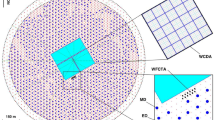Abstract
Introduction
The Large High Altitude Air Shower Observatory (LHAASO) will be constructed at Mt. Haizishan, Sichuan Province, China. Among several detector components of the LHAASO, the Water Cherenkov Detector Array (WCDA) is of great importance for gamma-ray astronomy from 100 GeV to 30 TeV. The single-channel counting rate of a photo- multiplier tube can reach as high as 30 -35 kHz, most of them are background noise hits from the low energy cosmic ray showers, bringing a big challenge on data transferring, data storage and event reconstruction.
Methods
In this paper, a dedicated trigger scheme and a fast noise filtering method aiming to deal with these high rate background noise hits are introduced. These methods are tested with some Monte Carlo simulation data, showing a fair efficiency in filtering background noise hits, while most of the real shower signals are kept.
Conclusion
This method is proposed to be applied in a stage of the online processing just after the data are acquired in LHAASO-WCDA.





















Similar content being viewed by others
Change history
13 March 2018
The original version of these four articles as below unfortunately contained a mistake. The category “Review” was incorrect. The correct category is “Original Paper”.
Notes
On how to calculate the spurious trigger rate, please read the “Calculating the spurious trigger rate” section below—the calculation formula is quite same.
References
T.C. Weekes et al., Observation of TeV gamma rays from the Crab nebula using the atmospheric Cerenkov imaging technique. Astrophys. J. 342, 379–395 (1989)
Z. Cao, A future project at tibet: the large high altitude air shower observatory (LHAASO). Chin. Phys. C 34(2), 249–252 (2010)
Z. Cao et al., LHAASO collaboration, Status of the Large High Altitude Air Shower Observatory Project. In 33rd ICRC (2013)
Z.G. Yao, et al., for the LHAASO collaboration, Design and Perfomance of LHAASO-WCDA experiment, 32nd ICRC (2011)
R. Atkins et al., Milagrito, a TeV air-shower array. Nucl. Instrum. Methods Phys. Res. A 449, 478–499 (2000)
T. DeYoung, The HAWC observatory. Nucl. Instrum. Methods Phys. Res. A 692, 72–76 (2012)
The Pierre Auger Collaboration, The Pierre Auger Cosmic Ray Observatory. Nucl. Instrum. Methods Phys. Res. A 798, 172–213 (2015)
K. Mase, for the IceCube collaboration, The latest IceCube results. Nucl. Instrum. Methods Phys. Res. A 766, 43–47 (2013)
R. Abbasi et al., for the IceCube collaboration, IceTop: the surface component of IceCube. Nucl. Instrum. Methods Phys. Res. A 700, 188–220 (2013)
H.C. Li, Z.G. Yao, C.X. Yu et al., A method to monitor and measure the water transparency in LHAASO–WCDA using cosmic muon signals. Chin. Phys. C 41(2), 026002 (2007)
Q. An, Y.X. Bai, X.J. Bi et al., The performance of a prototype array of water Cherenkov detectors for the LHAASO project. Nucl. Instrum. Methods Phys. Res. A 724, 12–19 (2013)
C. Li, S.B. Liu, L.F. Shang et al., The clock system for LHAASO WCDA based on reduced White Rabbit. Nucl. Sci. Tech. 23, 230–236 (2012)
D. Heck, J. Knapp, J.N. Capdevielle et al., Report FZKA 6019 (1998)
S. Ostapchenko, On the re-summation of enhanced pomeron diagrams. Phys. Lett. B 636, 40–45 (2006)
S. Ostapchenko, Nonlinear screening effects in high energy hadronic interactions. Phys. Rev. D 74, 14–26 (2006)
F. Aharonian, A. Akhperjanian, M. Bernl et al., Astrophys. J. 614, 897–913 (2004)
J.R. Horandel, On the knee in the energy spectrum of cosmic rays. Astrophy. J. 19, 193–220 (2003)
S. Agostinelli, J. Allison, K. Amako et al., Geant4a simulation toolkit. Nucl. Instrum. Methods Phys. Res. A 506, 250–330 (2003)
Z.G. Yao, M. Zha, Z. Cao et al., for the LHAASO collaboration, LHAASO simulation: Performance of the Water Cherenkov Detector Array. In 31st ICRC (2009)
Acknowledgements
This work is supported in China by NSFC (No. 11675187, No. 11375224, No. 11635011), and the Key Laboratory of Particle Astrophysics, Chinese Academy of Sciences.
Author information
Authors and Affiliations
Consortia
Corresponding author
Ethics declarations
Conflict of interest
On behalf of all authors, the corresponding author states that there is no conflict of interest
Additional information
A correction to this article is available online at https://doi.org/10.1007/s41605-018-0036-4.
Rights and permissions
About this article
Cite this article
Wang, XJ., Yao, ZG., Zha, M. et al. Trigger and noise filtering algorithms for the LHAASO water Cherenkov detector array. Radiat Detect Technol Methods 1, 14 (2017). https://doi.org/10.1007/s41605-017-0015-1
Received:
Revised:
Accepted:
Published:
DOI: https://doi.org/10.1007/s41605-017-0015-1




